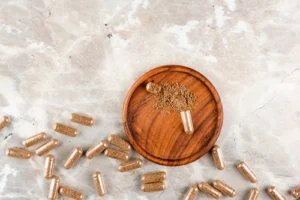
Ibogaine, a potent psychoactive substance sourced from the root bark of the African plant Tabernanthe iboga, is gaining global recognition for its significant effects on addiction, depression, PTSD, and spiritual insight. For those considering a full ibogaine experience, a crucial question emerges: What is the best form of ibogaine to take, and what is the appropriate dosage?
This comprehensive guide outlines key considerations for selecting the ideal ibogaine preparation, determining the correct dosage, and implementing necessary safety measures for a therapeutic or visionary journey.
Forms of Ibogaine and Their Differences
Before discussing dosages, it’s essential to understand that ibogaine is available in several forms, each with distinct strengths, effects, and ideal use cases. The primary types include iboga root bark, iboga total alkaloid (TA), and ibogaine hydrochloride (HCL).
Types of Ibogaine for Full Experiences
The form of ibogaine you choose will significantly impact the intensity, duration, and nature of your experience. Each type has unique properties suited to different intentions.
Iboga Root Bark
This traditional and least refined form of iboga has been used for centuries in Central African spiritual practices. It includes a full range of alkaloids, including ibogaine.
- Best for: Deep spiritual work, ancestral healing, Bwiti initiations
- Strength: Low (3-6% ibogaine content)
- Dose range: Up to 20-30g, depending on sex, body weight, tolerance, and experience
- Consideration: High volume may cause nausea, often making it unsuitable for beginners.
Iboga Total Alkaloid (TA)
TA offers a concentrated form that retains the full spectrum of alkaloids. It serves as a bridge between raw bark and purified ibogaine.
- Best for: Mixed use (spiritual and therapeutic)
- Strength: Moderate (~30-45% ibogaine content)
- Dose range: 1g to 7g, based on user’s sex, body weight, and experience
- Consideration: Requires careful weighing and management.
Ibogaine Hydrochloride (HCL)
The most purified and standardized form, containing over 98% of the active compound, is primarily used in clinical settings for addiction treatment.
- Best for: Addiction recovery and therapeutic interventions
- Strength: High (98-99% ibogaine content)
- Dose range: 10-25mg/kg for women, 15-35mg/kg for men
- Consideration: Dosage must be calculated based on body weight and health condition.
Determining the Right Dose: Key Factors
Ibogaine is not a uniform treatment; appropriate dosage varies based on individual characteristics and health status.
The recommended dose for individuals without pre-existing health issues is typically 10-25 mg/kg for women and 15-35 mg/kg for men.
- Health Condition: For individuals with heart, liver, or psychiatric conditions, only a qualified ibogaine provider should determine dosing. Mandatory ECG tests and liver panels help avoid serious complications.
- Age and Sex: Sensitivity varies by gender and age. Women often require lower doses due to metabolic and hormonal differences. Older adults should also start at the lower end of the dosing spectrum.
- Body Weight: Weight-based dosing minimizes overdose risk. For instance:
- Women: Start with 10-15mg/kg (maximum 25mg/kg)
- Men: Start with 15-20mg/kg (maximum 35mg/kg)
Example: A man weighing 70kg (154 lbs) would receive between 1050mg and 2450mg of Ibogaine HCL, depending on individual needs and tolerance.
Choosing the Best Form for Your Purpose
Each form of ibogaine has strengths depending on your goals—be it healing, detox, or personal growth.
- Therapeutic Use (Addiction Recovery, Depression): Ibogaine HCL is the most effective and safest option for overcoming addiction or treating resistant depression and PTSD. Its purity ensures predictable results and minimizes toxicity from other alkaloids.
- Spiritual or Visionary Experience: For those seeking spiritual growth or introspection, iboga root bark or TA may be more suitable. These forms offer a full spectrum of alkaloids, enhancing the spiritual aspect of the journey.
- Combination Approach: Some advanced users blend TA and HCL, where TA initiates gradual spiritual unfolding while HCL provides therapeutic reset. This method should only be undertaken with professional guidance due to dose overlap and toxicity risks.
How to Take Ibogaine: Administration Methods
The method of administration affects the onset, intensity, and safety of the experience. Each route has unique benefits and precautions.
- Oral Ingestion: The most common method, allowing natural absorption. Root bark, TA, or HCL is encapsulated or mixed in liquid and swallowed.
- Onset: 1-3 hours
- Duration: Up to 24 hours of active experience
- Considerations: Should be taken on an empty stomach to minimize nausea.
- Sublingual (Under the Tongue): Occasionally used for smaller doses or microdosing, allowing faster absorption.
- Onset: 30-60 minutes
- Considerations: Bitter taste, limited to smaller doses.
- Rectal Administration: Used in clinical settings for individuals with extreme nausea or those unable to tolerate oral ingestion.
- Onset: Fast, within 30 minutes
- Considerations: Requires expertise; not recommended outside medical supervision.
Safety Considerations and Precautions
A full ibogaine experience carries inherent risks that require careful preparation and attention.
- Pre-screening: Undergo thorough health evaluations, including ECG to assess heart rhythm and liver function tests.
- Supervision: Always have a trained medical professional or experienced guide present to monitor your vitals and provide emotional support.
- Environment: Choose a quiet, safe, and comfortable setting with minimal distractions. Control lighting, sound, and temperature.
- Hydration and Fasting: Avoid food 8-12 hours before dosing, stay hydrated without overdrinking, and avoid other medications unless medically approved.
Post-Ibogaine Trip Care and Integration
After the intense part of the ibogaine journey, the real work begins: integrating the lessons learned and transforming insights into actionable steps.
- Rest and Nutrition: Focus on rest, hydration, and light but nourishing meals. Avoid stimulants and processed foods during recovery.
- Emotional Support: Consider journaling, therapy, or support groups in the weeks following the experience. Processing emotions is crucial for long-term transformation.
Frequently Asked Questions
Q: Can I take ibogaine more than once?
A: Yes, but only under supervision. Full doses should be spaced several months apart, though microdosing protocols may continue for support.
Q: Is vomiting or purging normal?
A: Yes, especially with root bark or TA, purging is common and considered a form of physical and emotional cleansing.
Q: What are the dangers of overdosing?
A: Overdosing can cause seizures, heart arrhythmias, and, in extreme cases, death. Always follow the mg/kg guidelines and never dose without supervision.
Q: Is ibogaine legal?
A: Legality varies by country. Ibogaine is legal in some areas (e.g., Mexico, New Zealand), regulated in others, and banned in countries like the U.S.
Final Thoughts: A Sacred Medicine, Not a Shortcut
A full ibogaine journey can provide one of the most powerful resets for the body, mind, and spirit. However, it demands careful preparation, respectful use, and ongoing integration to reach its full potential.
Whether you seek healing from addiction, relief from emotional pain, or a renewed sense of purpose, ibogaine can be a potent ally. Remember: it’s not just about the trip; it’s about what you do afterward.
Respect the plant, respect yourself, and embark on your healing journey with intention, humility, and support. For more information, visit [ibogatreatments.com].
